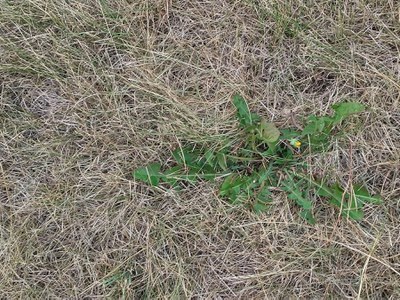Drought Survival Tips for Lawns
Many lawns across our state are brown and crispy. Are they still alive?
That may seem like an odd question, but we are experiencing an historic drought.
In normal years, there is nothing unusual about letting your lawn go dormant in summer. The grass turns brown and then rests in the heat. Then in September, the temperatures cool off and our lawns green up again.
But this drought has been very long with especially hot temperatures. Many lawns have suffered from drought going back to last summer.
This extended, severe drought has caused many non-irrigated lawns to suffer. Weak lawns growing on compacted soil and with excessive thatch are most vulnerable.
Fortunately, the most common lawn grass grown in North Dakota is Kentucky bluegrass. This grass has remarkable resistance to drought due to its ability to go dormant. A healthy bluegrass lawn can go several weeks, if not months, without watering.
For now, let’s focus on helping our lawns survive this historic drought:
Stay off a dormant lawn as much as possible. This includes mowing. We don’t want to crush the fragile crowns (growing points located near the soil) and the leaves of the grass plants.
Do not apply herbicides now. Although weeds are more noticeable in brown lawns, let’s wait until mid-September.
Some herbicides harm drought-stressed lawns. Plus, you will have much greater success killing weeds if you wait until the weeds are actively growing in fall.
Pause on fertilizing. Drought-stressed, dormant turf does not need fertilizer now. Wait until September when temperatures cool off. Select a fertilizer that contains potash, such as 30-0-10 or something similar. Potash helps turf to cope with drought stress.
Proper watering is important. Start by knowing how much water your sprinkler provides. Set a series of flat-bottom cups at 5- or 10-foot intervals away from the sprinkler. Measure the time it takes for a half an inch of water to fall into the cups.
Green and growing lawns in summer want a big gulp of one inch of water per week.
Brown, dormant lawns in summer are much less thirsty. Only a few sips of water may be required during an extended drought.
One-half inch of water every 2 to 4 weeks from rainfall or your sprinkler may help in the long-term survival of the lawn. Our goal is to keep the crowns of the grass plants hydrated and alive, but not necessarily active.
These crowns will send out new grass blades and roots when cooler temps and normal rainfall arrive.
Rain is in the forecast this week. Let’s hope these rains continue.
Later this fall we can assess any damage and repair the lawn if needed.
Written by Tom Kalb, Extension Horticulturist, North Dakota State University. Photo courtesy of Tom Kalb.
Sources:
Reicher, Z. Facts and advice on turf survival in drought. https://turf.purdue.edu/facts-and-advice-on-turf-survival-in-drought/. Purdue University. Accessed August 11, 2021.
Soldat, D. 2012. Keeping your grass alive during periods of extended drought. https://hort.extension.wisc.edu/articles/keeping-your-grass-alive-during-periods-extended-drought/. University of Wisconsin.
Zuk, Alan. Personal communication. North Dakota State University. August 18, 2021.


